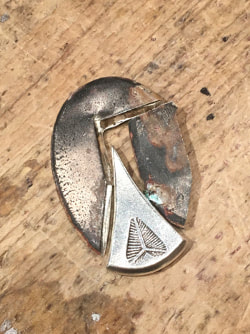 Written by Bob Quinn, LAc, DAOM I recently returned from Arizona where I visited the father-son team that makes our Gentle Spirit tools (see our website Store button at the top of this page---more tools are soon coming, by the way!). Ernie and Jon-Michael Lister are Navajo (Dine) silversmiths that work in the most traditional ways. Sadly many other traditional silversmiths are now taking shortcuts, some even outsourcing a good part of their work to India and China. That’s the world we live in. There are however no shortcuts taken by Ernie and Jon-Michael. Ernie’s work is actually in the Smithsonian Institute collection. In this short blog post I want to describe what goes into our Gentle Spirit tools and how they differ from others available. It is common in making teishin to work with silver wire as a starting point or to have a mold manufactured. I am not criticizing this practice—many good tools are made in this way— but Gentle Spirit tools are made in a much more time-consuming way, resulting in a higher quality product. Ernie and Jon-Michael smelt their own silver and cast it into silver ingot bars. This alone distinguishes them considerably. Perhaps in reading this some of you might think: what difference does it make to cast your own silver ingot bars? Silver is silver is silver after all, isn’t it? The short answer is: no. There is a difference between custom furniture and Ikea furniture; there is a difference between $200 wines and Trader Joe's special bargain wine. And there is an obvious difference between our Gentle Spirit tools and ones that are mass manufactured on industrial equipment. From these silver bars they chisel off sections of workable size (see photo). After that many hours of repeated heat, hammering, filing, chiseling, and polishing are involved in fashioning a Gentle Spirit tool—and, perhaps the most important ingredient of all, prayer. All this time spent working on the tools allows the silversmiths to hammer “spirit” into them. Ernie often attends traditional curing ceremonials on weekends, usually a 6-hour drive each way, and can sing many of the healing songs. There can be well over 100 songs in a given ceremony, and all must be sung precisely and in the right order. His brother is a Navajo healer. In short Ernie is both a modern man and a traditionalist. It is interesting to note that their main business is in making custom bracelets, mostly for Japanese customers. We love this connection to Japan, because it is in Japanese acupuncture that one finds teishin use raised to high art. Ernie and Jon-Michael manage to stay busy even without a website. People who know and appreciate quality find them, and there is a strong word of mouth effect when someone in Japan wears one of these bracelets. Others who see them want one for themselves. Ernie has a beautiful way of combining the Japanese wabi-sabi aesthetic with his tribal symbol system, and visitors to his shop recognize right away his unique mastery. To make just one of these bracelets requires two weeks of work for two people. That sort of approach is almost unknown in the modern world of shortcuts and quick fixes. Ernie and Jon-Michael bring this same commitment to the making of a Gentle Spirit teishin and when one holds them the quality is obvious. I have even seen one sensitive person break down in uncontrollable tears when she first held these tools! That is the strength of the prayers that have been hammered into the silver. In Japan it is possible to spend $1400 on a gold teishin; many options available there cost much more than our tools. I mention this because some balk at the cost of a Gentle Spirit teishin at $295. I am amazed actually that we can sell them at the price that we do, when one considers what goes into the making of these tools. I have shown these tools to three Japanese master acupuncturists and all three immediately recognized what special tools they are. Who should buy a Gentle Spirit teishin? I would not advise one of these tools as a starter teishin. It makes sense to first convince yourself that working with non-insertive techniques is something you really want to carry forward. That might involve a year or so of experimenting. Once you know though that you want to work in this gentle way, then it makes sense to purchase a quality tool. Your hands and the techniques they execute will always be the most important ingredients in the clinical recipe, but a good tool is crucial. We are proud to offer these Gentle Spirit tools and hope you consider them when you are ready to invest in a life-long healing tool. I add my prayers to Ernie’s and Jon-Michael’s that these Gentle Spirit teishin and other tools bring healing to your patients.
0 Comments
|
Authors
Blog posts are written by Onkodo practitioners. Archives
November 2020
Categories |
 RSS Feed
RSS Feed